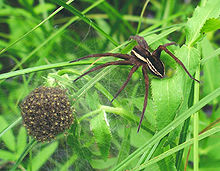Edged hunting spider
| Edged hunting spider | ||||||||||||
|---|---|---|---|---|---|---|---|---|---|---|---|---|

Edged hunting spider ( Dolomedes fimbriatus ) in a moorland pond |
||||||||||||
| Systematics | ||||||||||||
|
||||||||||||
| Scientific name | ||||||||||||
| Dolomedes fimbriatus | ||||||||||||
| ( Clerck , 1757) |
The fringed hunting spider ( Dolomedes fimbriatus ), also called fringed list spider , belongs to the family of predatory spiders (Pisauridae) and thus to the superfamily of the Lycosoidea . Like all predatory spiders, it wears its jaw- clawed egg cocoon ( chelicerae ) and guards its young in a dome-shaped web. The rimmed hunting spider is a very large and showy species of spider. The spider lives on the banks of stagnant or slowly flowing waters; it occurs in raised bogs , wet meadows , swamp forests and also in gardens .
The Arachnological Society named the Edged Hunting Spider Spider of the Year 2020.
features
The females reach body lengths between 15 and 22 millimeters, according to more recent information up to 25 millimeters, the males between nine and 15 millimeters. The predatory spiders differ from the similar wolf spiders in the position of the two rear pairs of eyes, which form a trapezium that is wider than it is long.
The basic color varies between yellow-brown and black-brown in both sexes. The animals have conspicuous yellow or white longitudinal stripes over the body flanks, which is where the commonly used term "edged hunting spider" comes from. In adult males, there may also be a smaller heart mark on the back of the otherwise dark brown body. In many specimens, especially young animals, less often older ones, the longitudinal stripes are also completely absent. The spider is then uniformly yellow-brown in color.
Dolomedes fimbriatus is very difficult to distinguish on the basis of its habitus and the great similarity from the closely related, also widespread in Central Europe, but less common "Rimmed water spider" ( Dolomedes plantarius ).
Way of life
The spider prefers to stay near water. The rimmed hunting spider can move with its thick hair on the water and also submerges in danger. In contrast to some wolf spiders , which can also hunt on the water (e.g. Pardosa , Pirata ), the edged hunting spider "swims" with the body. It is too heavy and needs all of the body hair to use the surface tension and "rows" with the third and second pair of legs. The legs are not stretched, but rotated in the hip joint. In this way she changes her land movement (diagonal movement of the legs) in the water. This movement is similar to that of insects , such as B. in water striders (Gerridae). The spider can also dive. The animal uses both abilities to escape from enemies and to catch prey.
Young animals in particular stay at a greater distance from the water, sometimes on higher vegetation, e.g. B. on bushes.
nutrition
From the water level, it not only catches insects and tadpoles , but also small fish , which it grabs with lightning-fast movements and kills in a few seconds with a poisonous bite. Very large prey is apparently only used by females during the egg maturation phase. The booty is pulled ashore and consumed there; it is often liquefied and absorbed in an act lasting several hours.
Reproduction and development
Mating takes place in May and June. The male does not give the female a bridal gift for mating, but waits for the female to catch something herself. While the female is eating, the male can approach the female. However, careless males are eaten in the process. The female hunting spider can lay up to 1000 eggs twice a year from the end of June, which are transported and guarded in a spherical, whitish to light brown cocoon with a diameter of one centimeter. Shortly before the young spiders hatch, this cocoon is often attached to the low vegetation in a bell-shaped web directly on the bank of the water and guarded for a while. The development of the young is two years. They usually hibernate subadult the first time and moult one last time in May. The young spiders are usually brightly colored with a greenish-yellow base tone. They often stay far from the shore.
Individual evidence
- ↑ Heiko Bellmann: Cosmos Atlas Arachnids of Europe . Franckh-Kosmos, Stuttgart, 1997, p. 196, ISBN 3-440-10746-9 .
- ↑ Heiko Bellmann: Die Gerandete Jagdspinne , Mysterious World of Spiders, accessed on April 18, 2019.
- ↑ Gerandete Jagdspinne, Gerandete Listspinne , Natur in NRW, accessed on April 18, 2019.
- ↑ Edged hunting spider , on the pages of the National Park Neusiedlersee Seewinkel, accessed on April 18, 2019.
literature
- Heiko Bellmann: Cosmos Atlas Arachnids of Europe . Franckh-Kosmos, Stuttgart, 1997, ISBN 3-440-10746-9
- Rainer F. Foelix: Biology of the spiders . Thieme, Stuttgart 1979, ISBN 3-135-75802-8
- Hänggi, Stöckli and Nentwig: habitats of Central European spiders . Center Suisse de cartographie de la faune, Neuchatel, 1995
- Jones, Dick: The Cosmos Spider Guide . Kosmos, 1990, ISBN 3-440-06141-8
- Heiko Bellmann: Spiders: observe - determine , Naturbuch Verlag, Augsburg 1992, ISBN 3-894-40064-1
- Frieder Sauer , Jörg Wunderlich: The most beautiful spiders in Europe. , Fauna-Verlag, 2001, ISBN 3-923-01003-6



